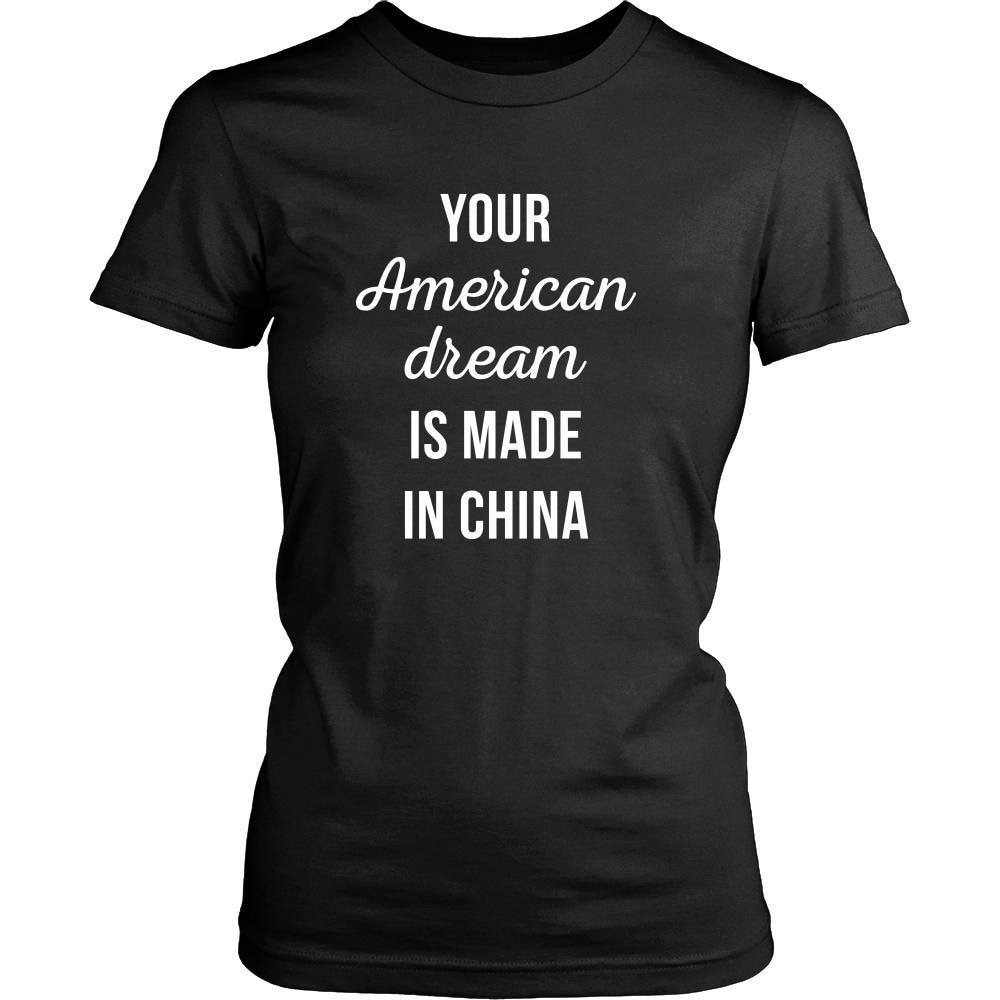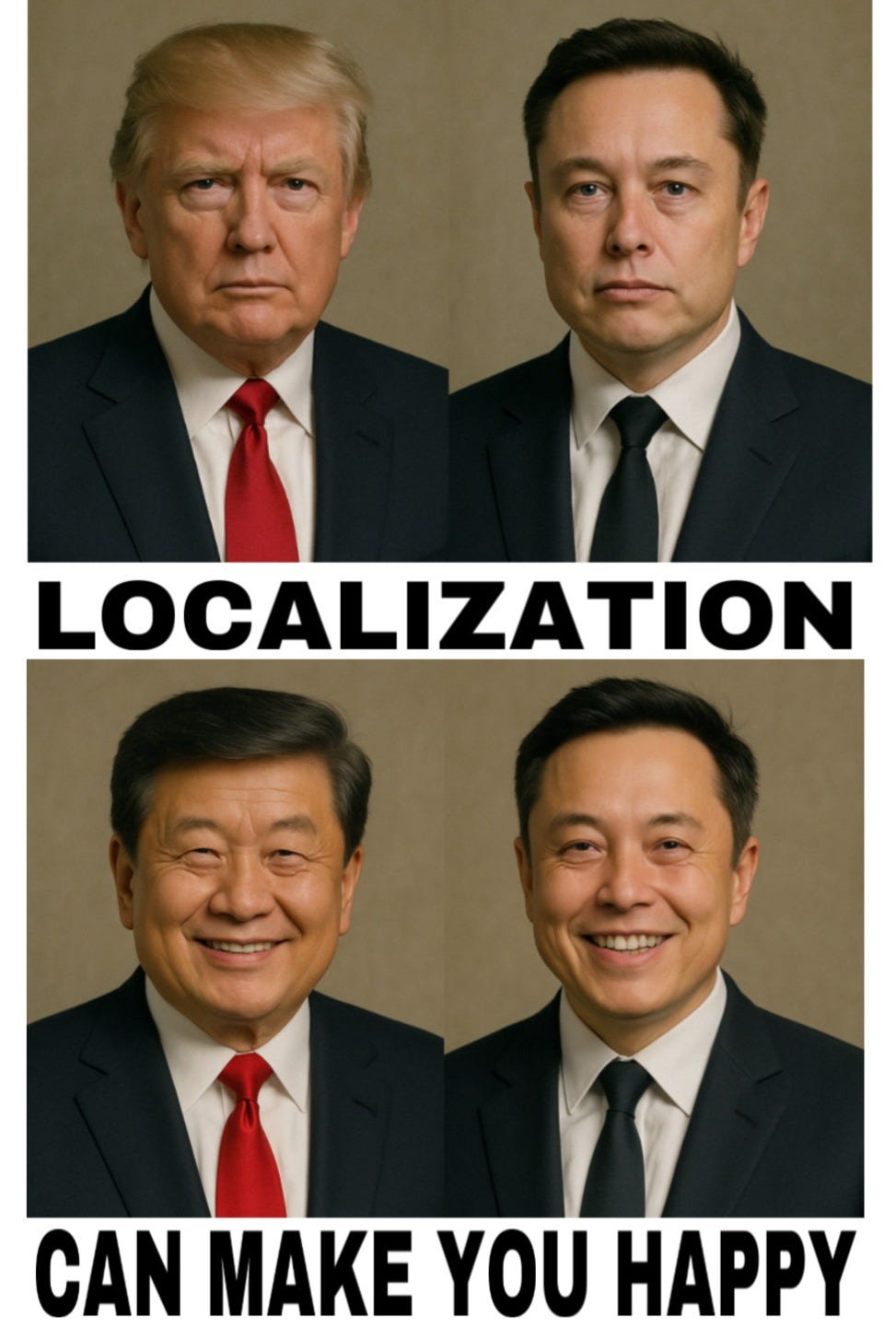Issue 28: Made in China… for China?
Why Trump’s Tariffs May Be Reshaping the Future of U.S. Business in China
If the latest barrage of tariffs from President Trump was designed to get American companies to "come home," then this is unlikely to succeed. Although it makes strategic sense for a country to manufacture its own pharmaceuticals or steel or battleships it is probably less mission critical to have manufacturing capacity for t-shirts, flip flops or plastic Christmas trees.
Most of the tariff fallout has understandably centred on American importers cutting costs, cutting wrists and looking to lie, mislead or hide where they are importing their products from. But there seems to be another story as well. The tariffs are conversely pushing some U.S. companies to adopt a more aggressive Make in China, for China strategy.
You may say “That sounds weird”. Yeah, kind of but let me explain what we are seeing.
From Made in China for Walmart to Made in China for WeChat
Historically, most U.S. brands set up operations or outsourced production to China to manufacture goods for U.S. consumers. Over time many have also found China to be a lucrative market rather than just a workshop.
With Trump's tariffs pushing landed costs of US products imported into China to unfeasibly high levels, we see some U.S. companies speeding up localised production, not to serve their market back home — but to sell within China.
After COVID, new joint ventures have been rarer than unicorns. So, when a U.S. client reached out a few months ago about setting one up in China, my first thought was exciting.
Things were going in the normal JV way – slowly. Then the Trump tariffs kicked off and I thought well that JV is not going ahead. Surely, they would have too much to worry about and life was chaotic enough — why add the complexity of a JV? However, how wrong I was. Within hours, both sides had sent emails saying that the JV was now critical. Deal terms were largely agreed by phone. The US CEO is scheduled to visit China in the following week. Both parties agree – no local assembly = no China market.
Another client is a U.S. auto parts supplier exporting brake pads from Guangzhou to Detroit. However, it is now tweaking its model to sell more directly into the China aftermarket — again with a Chinese partner as it looks to source for the US market from lower tariff jurisdictions where it has business in place.
The logic is simple: US products targeting the Chinese consumer are unlikely to be competitive if they are whacked with an immediate 125% tariff.
Is this New?
This is not really new. Many US (and other international) brands have been localizing/outsourcing production to China in the last decade in order to be successful in the world’s second-largest consumer market rather than trying to cut costs.
They get in. They sometimes joint venture – but less often than perhaps they should. They localise. They get closer to China so they know the market better and can adjust to the preferences of the fickle Chinese consumer more quickly.
What has changed is that the tariffs have fuelled the need for a China localization model for international brands being implemented NOW. Tariffs have morphed localization from being a sensible idea into a mission crucial to survive in the Chinese market.
Although, Western brands switching to local Chinese manufacturing will often reduce their costs. Not only are the manufacturing costs lower than in the West but also many of the raw materials, ingredients and packaging material come from China or can be more cheaply sourced from China. In addition, the logistics of manufacturing for China in China is not only more cost effective but also better environmentally.
Double-digit tariffs will make many imported USA products unattractive for the China market. The major challenge for many US brands will be to find the right OEM partner and then ensure this partner has sufficient capacity to produce for you.
Another motivation on the part of international brands for localization is a sneaking suspicion that the old ways of selling to China are no longer cutting it. The era of “ship it in, find a Tmall partner, and wait for money to flood in” is largely over. Indeed, even pure domestic online sales are not as beloved as before. Chinese consumers want interaction – so more pop-up shops, interaction and physical points of contact – even if they still mostly transact online.
Cosmetics as an Example
The cosmetics industry offers a perfect case study of why 'Made in China for China' is for many a requirement rather than an option. Localization is about much more than avoiding tariffs or lowering costs. Other benefits of going local include:
Chinese Consumers Have Already Gone Local … You Better as Well - Chinese consumer preferences are increasingly sophisticated, and they appreciate products which are adapted to the local market. Gone are the days when a French label or “Made in USA” was enough to open the wallets of Chinese consumers (or more likely a tap on WeChat pay). 2025’s Chinese consumers scrutinise ingredients, test textures, watch unboxing videos on Xiaohongshu, and compare dozens of reviews before making a purchase. Chinese locally made packaging often feels more premium than imported ones. Chinese consumers also appreciate similar values as high-end Western consumers. Looking favourably upon products that are perceived as being “clean,” sustainable and organic. In addition, Chinese consumers are keen to select products which are tailored to Asian skin or hair types. This local first approach will win out over generic global formulas or what works in New York or Paris.
Imported No Longer Immediately Associated with Superior – Many international brands still cling to the hope that Chinese consumers will always prefer Western products – this is very 2015. In 2025 Chinese consumers are China proud and even willing to buy locally manufactured baby formula. Local brands like Florasis, Perfect Diary, and Proya have reshaped the Chinese beauty market — not just by being cheaper, but by being better attuned to what Chinese consumers desire. Localisation goes beyond language — it includes brand story, design ethos, and how quickly a product can jump from concept to launch based on domestic trends. Many international brands now find themselves competing with C-beauty players who can launch three product lines in the time it takes for a U.S. brand to get its global compliance team to approve the font size on the box.
I feel the Need for Speed - Maverick in Top Gun could have been talking about cosmetic brands competing in the China market – speed to market is crucial. Chinese regulatory timelines are shorter if you are manufacturing locally. Non-special use cosmetics (such as skincare, lipstick, fragrances, shampoo and general makeup) no longer require animal testing if manufactured in China by qualified manufacturers – so no need to rely on cross border ecommerce to get these products into China.
In addition, domestic registrations are quicker and a smoother process. This is the case even though the requirements are largely similar. Domestic registrations do not need a GMP certificate, all local manufacturers already have manufacturing licenses and established accounts in the NMPA system which enables products/brands to be registered much more quickly. In addition, locally manufactured products face less scrutiny in terms of packaging. The days of imported products having Chinese stickers and “foreign language” packaging being considered prestigious are long gone. Also, if most raw material is supplied from China, then such local raw material suppliers are already registered with the Chinese authorities and therefore the process to record the raw material specifications is far faster than in relation to imported raw materials.
This means faster time to the China market and lower regulatory costs. By contrast, imported cosmetic products still require more paperwork and face longer delays due to batch-by-batch inspections and customs clearance. Speed-to-shelf is now a competitive advantage which local production can help unlock.
Chinese OEMs are World Class - Chinese OEMs are no longer a low-quality option. Today many top end Chinese OEM are ISO, GMP, and Ecocert certified and have a track record for manufacturing for high-end Korean, Japanese, European, and American brands. They are world class.
Also, in a world of uncertain geopolitics and fluctuating demand many US companies find outsourcing production to be highly sensible risk minimization strategy. The US cosmetics company’s strength will be innovation and branding – it will not have an advantage (indeed will have major disadvantages) in building or operating a factory in China. Although there is some work to be done, outsourcing is a very asset light-way to build your business in China.
One American skincare brand recently overhauled its supply chain to bring on two Chinese manufacturing partners. Officially, the rationale was risk mitigation. In truth, it was about survival. Without local production, their China team would need to move moisturisers priced at $50 for close to $95 by the new tariffs were imposed. This would not be a compelling offer — particularly when local brands and other non-US international brands are competing in the same market segment. Now, would this American skincare brand have been happier of they had picked one Chinese supplier and one Vietnamese supplier? Probably but such is life.
Go Local or Go Home?
This new approach — producing in China to sell in China — is not without challenges. The main challenges that Western companies must prepare for if they wish to localize manufacturing in China are:
Intellectual Property (IP) Risk - The biggest IP risk in China today is not some unknown counterfeiter — it is your trusted distributor or your own team. They know your formulation, your pricing, your pitch — and they might beat you to market with a lookalike. And their actions might not even be illegal if they are clever.
In this regard US brands are well advised to take common sense precautions:
Register IP Early and Often – to enforce your intellectual property rights in China, timely registration of relevant patents and trademarks is essential. The process is relatively inexpensive, but failing to register means you will have no legal basis to protect your rights. Worse still, if a counterfeiter gets there first, you could find yourself blocked from using your own IP.
Know who you are Dealing with – it is important to find the right OEM manufacturer. Work with one that has a good track record and works with several other international brands. It is better to have a bad contract with a good manufacturing partner rather than a good contract with a bad partner.
Good Contract – But a good partner is still worth having. Spell out the important issues, define what is not allowed and set clear redlines.
Responsible Agent - do not allow your distributor to be responsible agent in China. The role of the responsible agent will allow the distributor to have full access to all detailed, sensitive information of the Western brand including formula with concentrations of each ingredient, details of suppliers, explanation of the manufacturing process, efficacy report data (including clinical studies), test reports, safety data, etc.
Regulatory Risk – China’s regulations are evolving fast. Cosmetics faces particular regulatory risks – compliance, product claims, consumer data, online sales etc. These regulatory changes can be dynamic – what was fine six months ago may now trigger on-the-spot inspections or a social media backlash. Compliance is more than complying with your legal obligations - it is dealing with the authorities, protecting your reputation, proper social media engagement and in some cases understanding how algorithms will treat you.
This means you cannot afford a distant, underinformed compliance function. You need local regulatory intelligence — people who track NMPA regulatory changes, understand changes in SAMR policy, understand grey zones, and have direct lines into the various levels of administration.
In this regard it should be noted that the NMPA is building a fully digitised regulatory ecosystem — including product traceability platforms, efficacy claim substantiation filings, and adverse event monitoring. Domestic manufacturers must integrate into this system. While this raises the bar, it also gives companies greater visibility and control over their compliance footprint — essential for avoiding recalls, brand damage, or enforcement action. For Western brands used to informal distributor models this may actually reduce their risk – but it also means you likely will need to pay attention to regulatory change and not just rely on a distributor.
Liberation Day or Libation Day
Whether Trump’s tariffs lead to a Liberation Day of both reshoring manufacturing to the USA while also lowering prices or (more likely) several Libation Days where importers, Chinese factories and USA consumers alike start drowning their sorrows.
Although not the main consequence the tariffs will probably result in a “Made in China for China” model in a number of industries beyond cosmetics. Likely to be in industries as varied as health supplements to auto-parts, from mid-range fashion to homewares. Although the initial impulse will be to localize production it is possible that some U.S. companies with a large China business will need to treat China as more than a factory floor or a market — but as a second corporate home – one with its own cost base, regulatory logic, and consumer rhythm. China may not only be a source of revenue or growth but also inspiration and an early starter of trends that may become relevant globally.
How this trade war plays out remains to be seen ... but it seems the pendulum is swinging, and that this pendulum is swinging inwards. It may be that if you are not local in China by 2026, then you might not be here at all.






